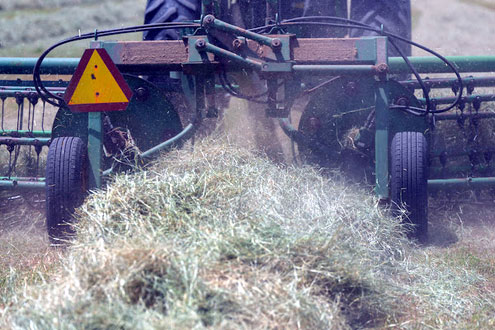Hay and forage conditions improved across the state with recent rainfall, setting the stage for promising hay yields and rangeland conditions for livestock grazing, according to Texas A&M AgriLife Extension Service experts.
First cuts of hay are in progress in many parts of the state, and producers are optimistic about prospective yields throughout the hay growing season.
“Currently, if anyone has already harvested or is preparing to harvest (hay) its most likely a majority volunteer annual ryegrass,” said Vanessa Corriher-Olson, Ph.D., AgriLife Extension state forage specialist and professor in the Department of Soil and Crop Sciences, Overton.
“I anticipate most first harvest will occur in the next two to three weeks. Most of Central Texas and East Texas has had good moisture recently, so that’s setting us up for a good first harvest.”

Corriher-Olson said producers’ 2025 hay season harvest outcomes will be “heavily dependent” on fertilizer applications and rainfall. Models suggest favorable rainfall in the upcoming months.
“According to the U.S. Drought Monitor, East Texas should have good growing conditions through the end of July,” she said. “Fingers are crossed.”
East Texas benefits from rain
Rain showers across East Texas have helped the emergence of Bermuda grass.
“We’ve had a lot of producers baling ryegrass and planting coastal Bermuda grass, which is a good thing,” said Truman Lamb, AgriLife Extension agent for agriculture and natural resources, Anderson County. “There have been a lot of folks doing soil tests, which we have been stressing for years. As the cost of fertilizer goes up, producers can’t afford to be over-applying or under-applying fertilizer.”
Hay prices for fertilized round bales in East Texas have been steady in the $60-$70 per bale range, while non-fertilized round bales are around $45 per bale.
“If the rain keeps coming, we will be OK,” Lamb said. “We are carrying over a lot of hay from last year. I’ve even seen hay still standing in the field and hasn’t been moved.”
Cattle producers will be watching hay yields to gauge how many bales to have on hand to fulfill herd feeding needs this winter. Lamb said producers are holding back enough heifers for replacement in their herds but continue selling cows and calves to take advantage of record-high cattle prices.
Brazos Valley optimism
Further south, producers shared a similar outlook despite drying conditions.
“Speaking with producers, they are positive about their first cutting due to the lack of a ‘late freeze’ that we can commonly see in late March, even early April,” said Chadd Caperton, AgriLife Extension agent for Brazos County. “The dryer weather is not good for growth but has allowed earlier access to baling the ryegrass to give summer forages an early start.”
Summer forages have benefited from favorable temperatures, Caperton said, but pastures and rangeland do need rain. Areas received some rainfall but it was not enough for continued forage production and below normal levels for this time of the year.
Caperton said most producers consider the first cutting a good start to their forage production season, but “they are also hesitant and less optimistic about early to mid-summer growth based on the current weather patterns.”
Texas is experiencing a neutral El Niño-Southern Oscillation, which typically means rainfall and temperatures are near their long-term averages.
Corriher-Olson said warm-season perennial grasses have broken dormancy and are actively growing.
“Some pastures likely still have some cool-season annuals that are being grazed,” she said. “It will be important as we move into summer that producers manage their stocking rates to reduce overgrazing prior to or during potential drought conditions.”

